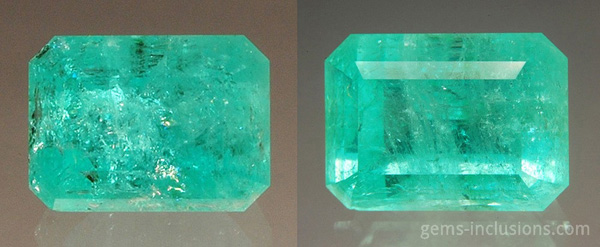- Home
- Inclusions info
Inclusions types
Inclusions in Gemology
Inclusions studies
- Inclusions photo galleries
- Inclusions shop
- Shopping info
- Additional info
- Contact us
Fissures and fractures
Fissures and fractures are very common in gemstones. Together with other internal characteristics, they are important for clarity grading of diamonds and colored stones. Fissures and fractures can be produced in different stages of gemstone’s existence:
- During crystal growth, as a result of internal tensions caused by structure defects or tectonic activity during mineralization.
- After crystals have been formed, but still in the host rock, due to changes of pressure or mechanical damage produced by tectonic activity.
- In secondary deposits, when gems are transported and accumulated, sometimes after traveling hundreds of kilometers from the mother rock.
- For primary deposits, during mining exploitation or the recovery process (blasting and crushing of the rock).
- During lapidary process – sawing, cutting and polishing – due to accidental blows or if internal tensions release and produce fissures.
- In some treatment procedures, provoked by thermal shock, usually with subsequent dying of flux healing to give synthetic gems more “natural” appearance
- In jewelry making or repair process (setting and other operations).
- Finally, during the use of a gem mounted in a jewelry object.

Octahedron diamond inclusion in polished diamond, with small fissure associated to mineral inclusion. Field of view 1.5 mm.
Fissures can have different shapes and sizes. A particular type of thin fissure following the cleavage plan of the crystal is called cleavage. Large fractures going through large parts of a gem’s volume can be dangerous for its integrity. In surface reaching fractures, part of the gem can be lost, giving place to an indentation (“nick” in diamond terminology). In some fissures, vivid rainbow colors can be observed due to thin-film interference effect. Surface reaching fractures can be filled by secondary minerals, providing them yellowish, brownish or reddish colors.
A large variety of treatment processes are used for fracture filling in gemstones, aimed to enhance their apparent clarity. Glasses of different compositions are applied to ruby, sapphire and diamond, artificial resins and oils are almost inevitable in emeralds, but can be applied to almost any other gem too.

Same faceted emerald, almost 10 carats, before and after fracture filling by oil.

Orange and bluish flash effect in natural Colombian emerald treated with artificial resin fracture filling. Field of view 4 mm.

A funny case – probably most curious fracture origin ever. This piece of green artificial glass, almost one kilogram weight, was submitted to IGE gem testing laboratory as supposed peridot. To check whether it was real or fake, the owner simply hammered it to see if it would break! A large fracture in the center of the sample is the result of this stupid experiment. Don’t do it at home, real stones do break too! :-)